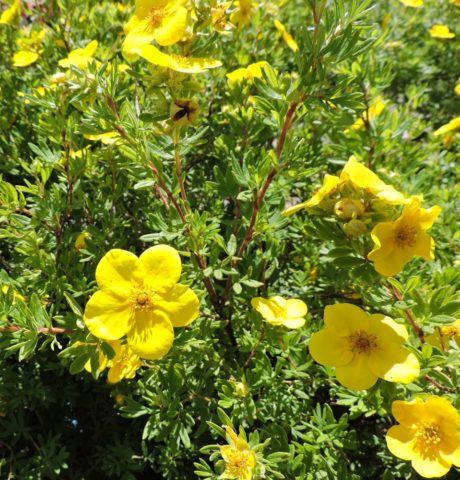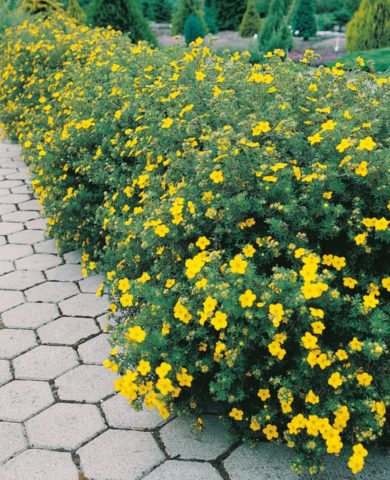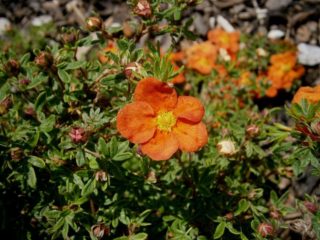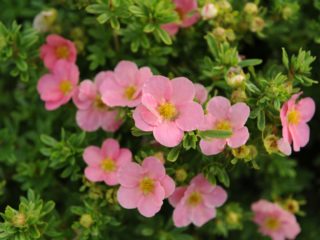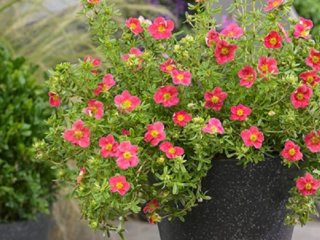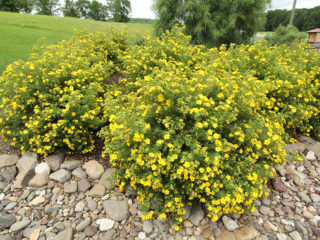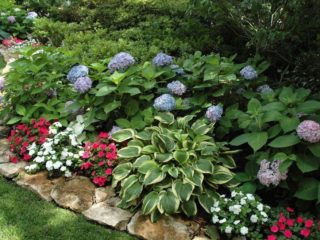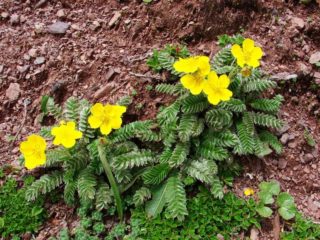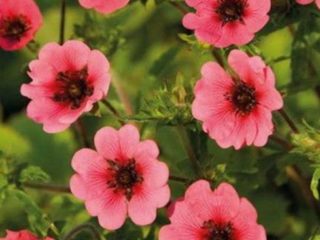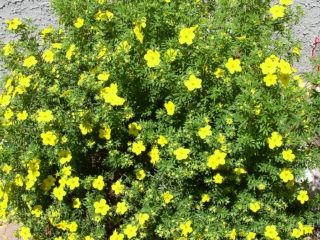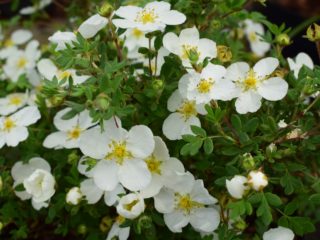Content
The bush cinquefoil is found in the wild in Altai, the Far East, the Urals and Siberia. A dark, tart decoction of branches is a popular drink among residents of these regions, which is why the second name for the shrub is Kuril tea. Cinquefoil Goldstar is a varietal representative of the crop, used for decorative decoration of personal plots.
Description of Potentilla Goldstar
Goldstar cinquefoil (pictured) is a popular crop used by professional landscape designers and amateur gardeners. The frost resistance of the variety allows it to be grown in the climate of the European part of Russia. Perennial Potentilla Goldstar gives an average growth of about 15 cm per year, holds its shape well throughout the growing season, and does not require constant crown formation. The unusual structure of the leaves and long flowering make cinquefoil decorative from spring to late autumn.After flowering stops, the color of the crown becomes dark yellow, the leaves fall off with the onset of the first frost. The Goldstar variety is wind-resistant, but does not tolerate moisture deficiency.
External description of Goldstar shrubby cinquefoil:
- A low shrub with a dense, compact, rounded crown. Height – 0.8-1.0 m, diameter – 1.0-1.2 m. The branches are erect, dark brown at the base, the color becomes lighter towards the top. The stems are thin, strong, flexible. Young shoots are pale green with a fleecy surface.
- Cinquefoil Goldstar is densely leafy, the leaves are pinnate, consist of 5 lobes in the form of an elongated oval, 4 cm long, 1 cm wide, lanceolate, thick, oppositely located. The surface is smooth, pubescent, dark green with a gray tint, the petioles are thin, of medium length.
- The flowers are simple, heterosexual, consisting of 5 rounded petals of bright yellow color, 4-5 cm in diameter with a velvety large core, formed on the tops of young shoots, arranged singly or 2-3 in an inflorescence.
- The root system is fibrous, superficial.
- The achenes are small, black up to 2 mm, ripen in early autumn.
The duration of flowering of cinquefoil is from June to September.
How does Goldstar yellow cinquefoil reproduce?
Cinquefoil Goldstar is a varietal representative of the species; when grown by seeds, it retains the characteristics of the parent bush. Reproduction options:
- cuttings. The material is cut from last year's shoots, less often from woody stems; in the latter case, the plant takes root worse. In June, cuttings up to 25 cm in size are cut from the middle part of strong shoots.Leaves and flowers are removed, the lower part of the material is lowered into “Kornevin” for 10 hours. Place it in the ground, create greenhouse conditions, cover it with cut-off plastic bottles, and water it constantly. The Goldstar variety is planted in a permanent place after 1 year;
- layering. The lower branch is fixed to the ground with staples and covered with earth. The procedure is carried out in the spring before the leaves appear. After a year, the plant is divided and planted;
- seeds. Planting material is collected at the end of September; in the spring, before sowing, the seeds are stratified and treated with a manganese solution. Sow in a mini-greenhouse on the soil surface.
When the shoots reach 10 cm, they are dived into separate containers. At the first stage of the growing season, the Goldstar variety grows quickly; after a year, the shrub is planted on the site.
Potentilla shrub variety Goldstar can be propagated by dividing a four-year-old bush. This method is rarely used; an adult plant does not always take root after transplantation.
Planting and caring for Goldstar cinquefoil
In favorable conditions, the plant blooms in the second year, developing and growing up to 4 years. Further vegetation is aimed at crown formation and flowering.
Recommended timing
Goldstar cinquefoil is grown from the Arctic Circle to the Southern regions, so planting times vary in each area. In warm climates, planting work can be done in the spring, after the snow has melted, when the soil has thawed enough to dig a hole. Approximately mid-April. Cinquefoil is planted in the fall in September, when at least a month remains before the onset of frost. This time is enough for the plant to take root in the area.In areas with cold winters, fall planting is not considered. Planting work is carried out only in the spring, when the soil has warmed up to +7 0C.
Site selection and soil preparation
Goldstar cinquefoil requires sufficient sunlight to bloom profusely. The site is determined without shade in an open space. The duration of the biological cycle of cinquefoil is 30 years; this factor is taken into account when choosing a location; an adult plant does not respond well to transplantation.
Preference is given to fertile loams; the soil composition should be light, aerated with satisfactory drainage. The soil may be neutral or slightly alkaline. In an acidic composition, Goldstar cinquefoil grows poorly, loses its decorative properties, and blooms weakly. The planting site is prepared in the fall. The area is dug up, if necessary, the acidic composition is neutralized with dolomite flour, and organic matter and urea are added. The photo shows the optimal size of a Potentilla shrub Goldstar seedling for planting; care recommendations are described below.
How to plant correctly
Before planting, Goldstar cinquefoil seedlings are checked for damage, and if necessary, dry or weak fragments of the root system and stems are removed. Dip the root into a growth-stimulating solution for 10 hours, then into a concentrated clay substance. Prepare a fertile mixture of sand, turf soil, compost in equal proportions, add ash and mineral fertilizers.
Planting Potentilla shrub Goldstar:
- Dig the planting hole so that the diameter is 2 times larger than the root system. The depth is determined by the length of the root to the neck plus 35 cm.
- A drainage layer (15 cm) is placed on the bottom.
- The nutrient mixture is poured on top.
- The seedling is placed in the center of the hole and covered with soil left over from digging the hole.
After planting, the plant is watered. One bush requires approximately 10 liters of water; the root circle is mulched with sawdust mixed with peat or crushed tree bark. When creating a hedge, the interval between plants should be 35 cm.
Growing rules
Kuril tea Goldstar can be classified as an undemanding representative of the species. Like any ornamental shrub, cinquefoil requires some care.
Watering
The Goldstar variety is characterized by average drought resistance. In its natural environment, the shrub is often found in wetlands along the banks of water bodies. It tolerates waterlogging of the soil more calmly than a dry root ball. Young cinquefoil seedlings up to 2 years old are watered every evening at the root, and sprinkled three times a week. Watering for adult plants is oriented towards seasonal precipitation; it is necessary that the tree trunk circle is always moist.
Top dressing
During spring planting, microelements necessary for growth are added. At the end of August, you can feed the cinquefoil with an organic solution. From next spring, before the buds appear, urea is added, and at the beginning of flowering, potassium fertilizers are applied. In early August, Goldstar cinquefoil is fertilized with superphosphate. After flowering, add organic matter and sprinkle the root circle with ash.
Loosening, mulching
Loosening is a mandatory condition of agricultural technology; the event is relevant for young seedlings. The top layer of soil must not be allowed to compact. For the formation of the root system, an unimpeded supply of oxygen is necessary. For an adult Goldstar variety, three loosenings per month are enough. Weeding is carried out as they grow.Weeds are a breeding ground for pests and infections.
Mulching of cinquefoil is carried out immediately after planting, using peat, tree bark or sawdust. In autumn, the layer is doubled and straw or pine needles are used. In the spring, the material is updated. Goldstar cinquefoil mulch has a multifunctional purpose: it retains moisture well, allows oxygen to pass through, and prevents overheating of the root system in summer.
Pruning, bush formation
The plant calmly responds to the formation of the crown; the structure of the bush allows you to create any shape depending on the design decision. After pruning, it remains decorative throughout the season and does not require re-shaping. The photo shows an example of using Goldstar cinquefoil as a hedge.
Pruning required for Goldstar Potentilla:
- Sanitary. It is carried out in the spring until the buds swell, and the shrunken, weak, bent, and intertwined stems are removed. They cut off shoots and top shoots, raise the crown, improve ventilation and light transmission.
- Rejuvenating. Old central stems are cut out, which affect the decorative appearance of the shrub and give the cinquefoil an unkempt appearance. The stems are cut off near the root. Rejuvenating pruning is carried out once every 3 years in case the tops of old stems dry out, if they do not produce growth and, accordingly, flowering.
- Molding. The crown of the Goldstar variety is formed in the fall, all shoots are cut to 1/3 of the length.
After 6 years of growing season, the Goldstar cinquefoil shrub is cut off completely, leaving the stems 15 cm above the root; in the spring the plant will recover, the young stems forming the crown will bloom profusely.
Pests and diseases
The resistance to infection and pests of the Goldstar cinquefoil variety is satisfactory.The plant gets sick infrequently; at low air humidity and high temperatures, spider mites parasitize the shoots of the cinquefoil; the drugs “Floromite” and “Sunmite” are used to control pests. The spread of cutworm butterfly caterpillars is possible; the pest is destroyed with the preparations “Decis” and “Zolon”. Fungal infections may cause powdery mildew; at the first sign, Goldstar cinquefoil is treated with Bordeaux mixture.
Conclusion
Cinquefoil Goldstar is a perennial deciduous shrub with long, abundant flowering. The culture is frost-resistant, tolerates temperatures down to -40 0C, and resists wind well. This light-loving ornamental shrub is demanding when it comes to watering. Goldstar cinquefoil is used in landscape design as a tapeworm and hedge. Included in a composition with low-growing flowering plants.
